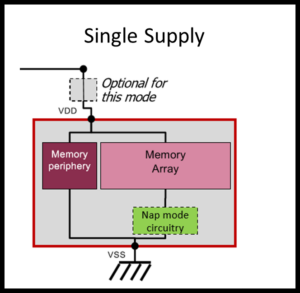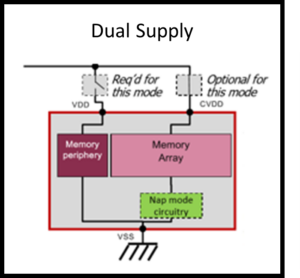1 and 2 Port Register File Memory Compilers
Compilers Overview
Silvaco has 25 years’ experience in compiled memory design. Its technology is silicon proven in thousands of designs and millions of wafers.
- Compilers for SRAM (single and dual Port), Register File (1 port and 2 port), and ROM
- Deployed at 12 different foundries and IDM’s
- Available in processes down to 22nm
Register File Compiler Features
- Optimized for low power, general purpose and high performance applications
- Effective power management with multiple power modes and options
- High Performance through Multiple voltage threshold (Vt) options and operating modes
- High Yield
- Verified for global and local variation tolerant design
- ECC bits, word size and address flexibility for redundancy
- Available technologies include 180nm, 152nm, 130nm, 110nm, 90nm, 85nm, 65nm, 55nm, 40nm, 28nm and 22nm
- CMOS processes variants covered include G, LP, SOI, and SRAMs in CMOS in the High Voltage, BCD, and eFlash foundry offerings
- Can easily port to other nodes and processes
Register File Memory Architecture
- Proprietary architecture designed for high density and low power provides lower area
- Multiple low power modes including Standby, Retention, and Shutdown modes
- Embedded switches support
- Available in
- Single supply
- Dual supply rail for periphery and core
- Data retention mode
- Byte mode for write operations
- Optional support for Built in Self Test and Repair (BIST/R)
| Feature | Benefit |
| High density | Industry leading area |
| Partitioned array | Extended battery life |
| Several operating modes | Up to 50% lower power consumption |
| Data retention mode | Reduce leakage current |
| BIST (optional) | Increase reliability and yield |
Register File Low Power Operation Modes
Silvaco Register File compilers offer a range of low power operation modes with different leakage and wake-up times.
| Mode | Description | Leakage* |
| Active Core: On @ Vdd | · Read or write · Core and Periphery powered and operational. · Dynamic power and small Leakage power consumption | — |
| Standby Core: On @ Vdd | · No read or write. · Core and Periphery powered but not operational · Small Leakage power but no Dynamic power consumption · Quick Wake Up time | 1.00 x |
| Retention Core: On @ < Vdd | · Periphery power turned off · Core at minimum voltage to retain data · Lower Leakage power consumption than Nap · Slow Wake Up time depends on powering up periphery switches and other circuits | 0.54 x |
| Shutdown (Data Content Lost) Core: OFF | · Core and Periphery switched off · Lowest Leakage power consumption · Slowest Wake Up time | — |
Memory Configurations
Silvaco Register File compilers support different voltage supply configurations. The compilers also support a wide range of mux and word width configurations.



